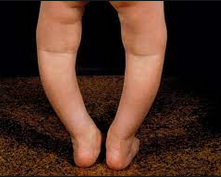- Clinical history
- Physiologic bowing is the most common cause of bow legs and is seen from birth until two or three years of age.
- Be aware of pathological causes such as rickets and Blount’s disease.
- Physical examination
- determine the patient’s height and weight percentiles
- assess in-toeing
- measure intercondylar distance in standing with feet together
- Investigations

- X-ray of knees if:
- unilateral deformity
- progressive deformity
- lack of spontaneous resolution
- aged over three years old
- consider checking Vitamin D in at risk groups
- GP management
- Reassure the parents that physiological bow legs will resolve by age three with normal development. No specific treatment is required.
- If concerned, serial measurement of intercondylar distance every six months to document progression or resolution may be useful.
- Indications for specialist referral
- persistence of bow legs after 3 years of age
- intercondylar separation is more than six centimetres
- asymmetrical deformity
- excessive deformity
- progressive deformity or lack of resolution
- pain after a traumatic event
- other associated skeletal deformity such as height below fifth centile for age
Related